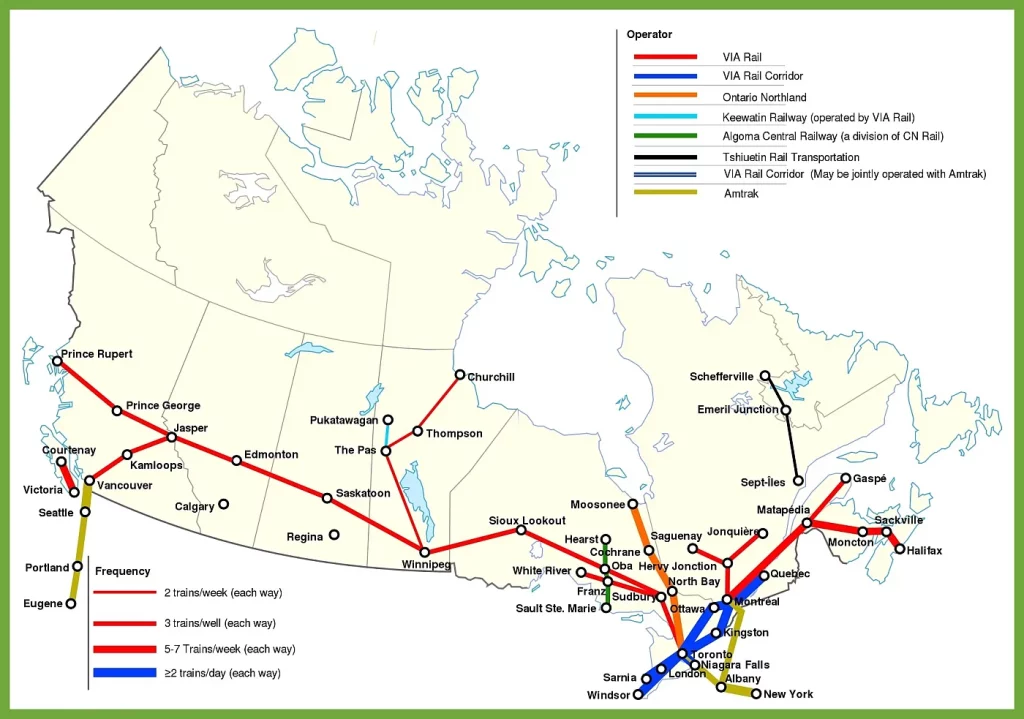Railroads have played a crucial role in shaping the history and economy of Canada. As a vast and expansive country, railways were essential in connecting its cities and towns and facilitating goods and people transportation. In this article, we will take a closer look at a map that shows the railroad system in Canada and explore its significance in the country’s development.
Railway map of Canada
This map shows railroads in Canada.

This map displays the railway system of Canada. It is a detailed representation showing various railway lines crisscrossing the country. The map likely includes major transcontinental routes and regional lines connecting different parts of Canada. The lines are color-coded or labeled to distinguish between different railway companies or types of service, such as passenger or freight. Key cities and junctions along the routes are marked, providing a clear overview of Canada’s rail network and connectivity. Given the image dimensions 1024 by 719 pixels, the map is designed to be easily viewable on digital platforms, offering a comprehensive guide to Canada’s railway infrastructure.
What are Railroad Maps Used For?
Railroad maps provide a comprehensive view of the railway system in a particular region or country. They show the location of rail lines, stations, and other related infrastructure, making it easy for people to plan their travel routes, especially when traveling by train. Railroad maps also provide valuable information to freight and logistics companies, allowing them to transport goods efficiently and manage their supply chain.
Did You Know About Canada’s Railroads?
- Canada boasts an extensive railway system, with approximately 49,000 kilometers of track, making it one of the top five countries in the world in terms of railway network size. While it is not the most comprehensive globally, Canada’s rail network remains a vital component of its transportation infrastructure, with the United States holding that title. It plays a key role in both freight and passenger transport across the country.
- The Canadian Pacific Railway and the Canadian National Railway are two of the country’s largest and most important railroads.
- The first Canadian railway was built in 1836, running from Laprairie to Saint-Jean, Quebec.
- The Canadian railway system played a significant role in the country’s economic growth and development, allowing goods to be transported more efficiently and opening up new markets.
- Many of Canada’s most iconic train journeys, such as the Rocky Mountaineer and the VIA Rail Canadian, offer breathtaking views of the country’s natural landscapes.
Significance of the Railroad System in Canada
The railroad system in Canada played a significant role in the country’s development and continues to be an essential component of its transportation infrastructure. Railways are crucial in connecting Canada’s cities and towns, especially those in remote areas that are not easily accessible by road. The railroad system also plays a crucial role in facilitating the transportation of goods, which is essential for Canada’s economy. Railways transport many products, including raw materials, finished goods, and people.
The Canadian railway system has also profoundly impacted the country’s culture and history. Many iconic railway journeys, such as the cross-country Canadian, have become part of the Canadian identity. The railways have also played a significant role in shaping the settlement patterns of the country, with many towns and cities developing around railway stations.
Conclusion
Railroads have played an essential role in the development of Canada, connecting its cities and towns, facilitating the transportation of goods and people, and shaping its culture and history. The railroad map of Canada provides a valuable resource for those looking to explore the country by train, plan their travel routes, or better understand the country’s transportation infrastructure. By studying Canada’s railway system, we better understand how transportation has played a significant role in shaping the country we know today.